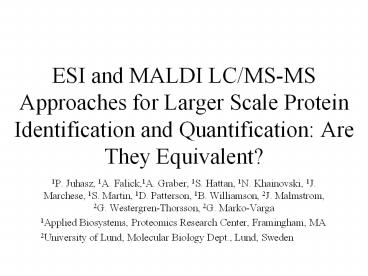ESI and MALDI LC/MS-MS Approaches for Larger Scale Protein Identification and Quantification: Are They Equivalent? PowerPoint PPT Presentation
Title: ESI and MALDI LC/MS-MS Approaches for Larger Scale Protein Identification and Quantification: Are They Equivalent?
1
ESI and MALDI LC/MS-MS Approaches for Larger
Scale Protein Identification and Quantification
Are They Equivalent?
- 1P. Juhasz, 1A. Falick,1A. Graber, 1S. Hattan,
1N. Khainovski, 1J. Marchese, 1S. Martin, 1D.
Patterson, 1B. Williamson, 2J. Malmstrom, 2G.
Westergren-Thorsson, 2G. Marko-Varga - 1Applied Biosystems, Proteomics Research Center,
Framingham, MA - 2University of Lund, Molecular Biology Dept.,
Lund, Sweden
2
Introduction a conventional PMF MS/MS approach
for protein identification
MALDI
yes
PMF
3
no
ESI
yes
nanoESI MS/MS
Id. OK?
no
97
derivatize sample
nanoESI MS/MS
Shevchenko et al, PNAS USA, 1996, 93, 14440-14445
3
New workflows facilitated by MALDI MS/MS
technologies
4
Objectives
- Characterize (dis)similarity of protein
identification results from LC-ESI MS/MS and
LC-MALDI MS/MS wokflows - Interpret results based on the ESI vs. MALDI
ionization preferences - Compare performance (quantification and
identification) in a protein differential
expression study
5
Case Study 1 Haemophilus ducreyi
- H. ducreyi is a gram-negative bacterium that
causes the sexually transmitted disease
chancroid. - Linked to the heterosexual transmission of HIV in
developing countries. - The sequencing of this genome (1.7Mb) has
recently been completed and homology with H.
influenzae is known. - A proteomic study was undertaken to help with the
sequence alignment and annotation.
http//www.microbial-pathogenesis.org/H.ducreyi/
6
H. ducreyi workflow
2
20 SCX fractions collected
1
200 mg cell lysate of h. ducreyi strain
35,000 reduced/alkylated and digested w. trypsin
50
50
3
3
45-min. gradient HPLC at 0.5 ml/min
90-min. gradient HPLC at 0.3 ml/min
matrix infusion at 1 ml/min
collection of 20-sec. fractions
Online MS-MS analysis on QStar Pulsar System
4
MS-MS analysis on AB 4700
7
Flow of data processing
Fraction 1
Fraction 2
db search (Mascot)
db search (Mascot)
Fraction 3
Fraction 4
Fraction 5
Protein list 1 Protein list 2 Protein list
3 Protein list 4 ...
Protein list 1 Protein list 2 Protein list
3 Protein list 4 ...
non-redundant list of proteins
non-redundant list of proteins
non-significant proteins removed
non-significant proteins removed
- Compile in Oracle db
- generate quieries
8
H. ducreyi proteins identified by 2D LC
(requiring at least 1 significant peptide)
498
372
ESI - QSTAR Pulsar System
MALDI AB 4700 Proteomics Analyzer
Successful MS/MS Spectra 2498/7414 (34)
Successful MS/MS Spectra 1709/6222 (27)
292
206
80
578 total unique proteins identified
9
Different ESI vs. MALDI characteristics on the
peptide level
10
How many peptides identify a protein?(h. ducreyi
work)
MALDI
ESI
The distribution of h. ducreyi proteins
identified by 1, 2, 3,..,etc. peptides
11
Conclusions from h. ducreyi work
- From very complex mixtures MALDI had better
efficiency of identification (higher MS/MS duty
cycle) - Smaller peptides with K C-terminus identified
more efficiently with ESI - Larger/more basic peptides are more efficiently
identified by MALDI - A more complete sequence coverage of proteins is
expected to smooth out differences
12
Case Study 2 Fibroblast activation by TGF-b
Fibroblast
SMAD Pathway
TGF-b
SMAD complex
DNA binding partner
Transcription
DNA
Myofibroblast
13
Differential expression analysis of nuclear
proteins in human fibroblasts
30 SCX fractions collected
control
10 ng/ml TGF-b
2
1
3
Cys-containing peptides affinity purified/
cleaved with TFA
Protein preps. from 107 fibroblast nuclei are
labeled with acid cleavable ICATTM
reagent/trypsinized
4
4
45-min. gradient HPLC at 1 ml/min
90-min. gradient HPLC at 0.3 ml/min
matrix infusion at 2 ml/min
collection of 20-sec. fractions
Online MS-MS analysis on QStar Pulsar System
5
MS-MS analysis on AB 4700
14
Preliminary results from SCX fraction A7
200 unique proteins identified and quantified
21
Unique MALDI
26
Unique ESI
50
Common
60
45
95
68
61
104
0
20
40
60
80
100
120
15
A few examples of differentially expressed
nuclear proteins identified by ESI or MALDI only
16
Comparison of quantification results
MALDI
ESI
heavy/light2.28
heavy/light2.49
gi11416507, enigma protein, AFYMEEGVPYCER
(MH1828.826)
ESI
MALDI
heavy/light2.17
heavy/light2.12
gi118090, peptidylprolyl isomerase B
(cyclophilin B), DVIIADCGK (MH1168.625)
MALDI ratio ESI ratio
0.017 /- 0.122
(based on 75 common peptides)
avg. ratio
17
Conclusions from protein differential expression
study
- ESI vs. MALDI are complementary 52(!) of
proteins were identified with ESI or MALDI only
when analysis is restricted to Cys-containing
peptides. - Protein quantification by isotope ratio
measurements (using ICATTM reagent) yielded
identical results with ESI and MALDI within the
experimental errors

